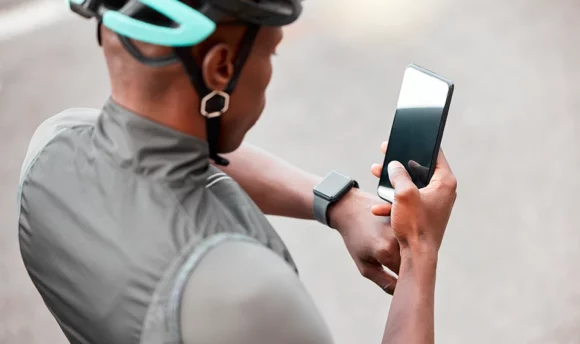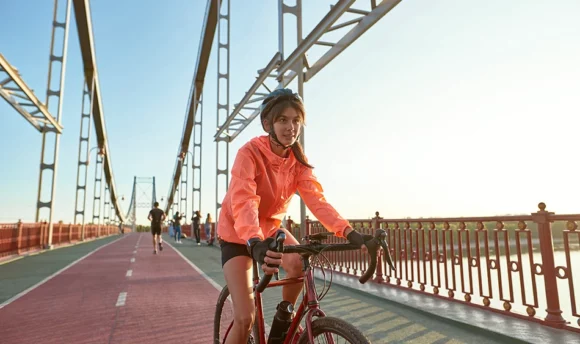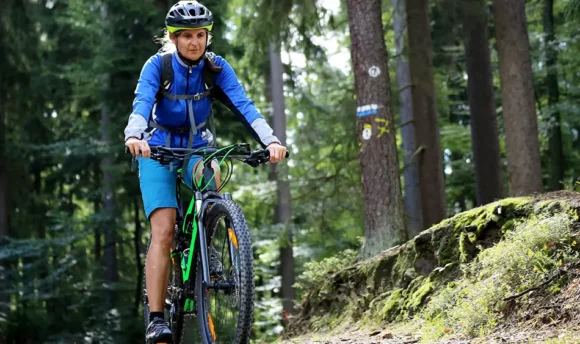Make The Most Out of Your Ride: 14 Cycling Tips for Beginners
Are you new to the world of riding bikes and eager to hit the road with confidence? These 14 beginner cycling tips will help set you up for success.

Taking the first steps in any new sport can be scary. And especially when it involves shelling out hundreds of dollars before even hitting the road.
But whether you want to ditch the car and ride your bike to the office, start leisure cycling for fun, or embark on a fitness journey from the seat of your bicycle, we’re here to help.
In this article, you’ll learn everything you need to know, from bike selection and safety gear to basic maintenance and riding techniques – we’ve got you covered.
#1 Make Sure Your Bike is Right for You
The first step in figuring out if your bike is a good fit is determining the style of riding you want to do. A road bike will be the best option for anyone intending to go long distances on paved roads, while the cushy suspension of a mountain bike is ideal for trail riding.
Once you’ve narrowed down your ideal bike style, you can use a calculator like this one to figure out your recommended frame size. A pre-purchase test ride can be used to ensure that you’ve found an adequate bike fit for your body and goals.
#2 Invest in a Quality Bicycle
An easy way to tell if your bike is high-quality is to put it through a simple weight test. Generally, lighter bikes are made from higher-quality materials like carbon fiber, titanium, or lightweight aluminum.
A bike having disc brakes, which are a style of brake that uses friction against metal discs to slow you down instead of pressure applied directly to the wheel’s rim, can be another indicator of quality. Especially when made by companies like Shimano, Campagnolo, and SRAM.
#3 Wear Safety Gear
As important as your bike itself is the safety gear you use while riding it. Quality helmets are a good idea for all riders, especially if you plan to cycle off-road.
It’s also a good idea to invest in a front and rear light and reflective vest to use while riding at night. These are considered bike essentials, as they make it easier for cars and other bikers to see you in the dark.
#4 Get Comfortable With Shifting Gears
Most bikes have two gears – located on the rear wheel and right pedal, with a chain connecting the two.
They are used to control the rotation of the rear wheel, with high gears better for maximizing speed and low gears for climbing hills.
Before taking your new toy out for a ride, it’s a good idea to use a short ride around an open area to get a good grasp of how to use your bike’s shifters to change gears.
#5 Stay Hydrated
When riding, there are several different options that you can use to ensure you stay hydrated during your ride. A water bottle is the simplest and cheapest option, but many cyclists prefer to use a hydration pack, which can be used for hands-free drinking.
#6 Learn Basic Bike Maintenance
Knowing the simple steps to keep your bike in good working order will not only improve the longevity of your bike, but will also give you the tools you need to fix common bike malfunctions without an expensive trip to the bike shop.
It’s important to always keep your bike clean. Clean it whenever you notice buildup or after taking it out in the rain, as this is the best way to lengthen your bike’s natural lifespan.
Before beginning your biking journey, you should also browse online for tutorials on how to clean and lubricate your bike chain, check your tire pressure, and, most importantly, how to use a spare tube to repair a flat bike tire.
#7 Keep Track of Your Progress
Tracking your progress by recording the distance you ride each day and how hard you found a particular ride is an easy way to stay engaged in your new habit.
A good biking distance for beginners can be anything between 6–18 miles, and by recording your rides, you’ll know when it’s time for a new challenge.
#8 Practice Proper Posture
Getting a professional bike fit is one way to prevent aches and pains while riding. But if you’re not a professional cyclist who plans on spending hours a day cycling, paying for a bike fitting can feel like overkill.
Instead, your best option for improving your cycling performance and eliminating riding-related discomfort is to practice proper posture. While cycling, focus on keeping your elbows slightly bent, relaxing your shoulders, and aiming to keep your knees stacked directly over your ankles.
#9 Don’t Forget to Stretch
Studies have shown that pre-cycling static stretching can negatively affect athletic performance. Instead, it’s best to pencil in your stretching after your ride to help with muscle recovery and prevent future muscle imbalances.
#10 Participate in Group Rides
Finding a cycling club to go on rides with can offer several benefits to new bikers. First and foremost, anyone interested in making new friends will have the opportunity to socialize with a new group of people who also share a common interest.
If you’re riding bikes to lose weight or get in better shape, group riding also has the added benefit of multiple accountability partners pushing you to get out for a ride.
#11 Invest in a Good Lock
A good rule of thumb for buying the right bike lock is to follow the 10% rule, which recommends spending 10% of your bike’s cost on your lock. For example, spending $20 on a bike lock for a $200 bike or purchasing a $100 bike lock for a bike costing $1,000.
The more expensive the lock, the more difficult it will be to break. Hence why more expensive bikes require heftier security.
#12 Learn the Rules of the Road
Cyclists aren’t exempt from following most of the same rules for car traffic. It’s important to always be aware of signage, yield to oncoming traffic, stay off sidewalks, and bike ride on the appropriate side of the road.
#13 Practice Riding in Different Weather Conditions
As with every outdoor sport, you can’t expect that the weather will always be perfect.
Get in the habit of checking the forecast before heading out, and if it calls for rain, consider packing a reflective vest in your backpack or handlebar bag that you can use to increase visibility in the case of a downpour.
Also, take care when cycling around corners, and begin pumping your rear brake and front brake earlier than usual, as riding on wet surfaces can reduce traction.
#14 Take Cycling Classes
Also known as spin classes, cycling classes offer a great opportunity for increasing your physical performance, enhancing motivation and accountability, and have the added benefit of offering more variety to your cycling workouts.
A Word From Our Coach
Beginning your cycling journey can feel both scary and exciting. To ensure that your entry into cycling is a pleasant one, it’s important to plan a first ride that is appropriate for your particular skill level.
Finding a part of your city that is bike-friendly, meaning that it has designated bike trails and little to no traffic, is a great place to start.
You may also consider planning out your route, ensuring that it has mostly flat terrain and will take no longer than 30–60 minutes to complete.
While biking, you should also aim to be within your aerobic capacity, meaning that your heart and lungs can deliver the appropriate amount of oxygen to your muscles. You can measure this by not exceeding a pace at which you have enough air to carry on a conversation.
FAQs
The best bike for a beginner cyclist is a cruiser or hybrid bike. These have the classic bike look, with wide handlebars and big comfy seats, and are best for cruising at slow speeds on relatively flat surfaces.
An essential step in starting your cycling journey is choosing the right bike – ideally, something that you can ride comfortably for long periods, and finding the appropriate terrain to use it on. Beginner cyclists are recommended to ride in areas with a designated paved bike lane and very little traffic.
In a perfect world, nobody would be cycling tired, as being fatigued can affect your reaction time and cycling performance. That being said, if you have to bike at night or after a long shift, make sure to use bike lights and ride slowly so you can spot potential danger.
The Bottom Line
These 14 beginner cycling tips provide a solid foundation that you can use to kickstart your cycling journey with confidence.
These guidelines are designed to not only help keep you safe but also enhance your progress and make your biking experience an overall more positive one.
Remember to start at your own pace, prioritize safety gear, and gradually build your skills and endurance. Whether you’re commuting, leisure riding, or pursuing more ambitious cycling goals, these tips will help you navigate the road ahead with ease.

















































 Select your language:
Select your language: 








